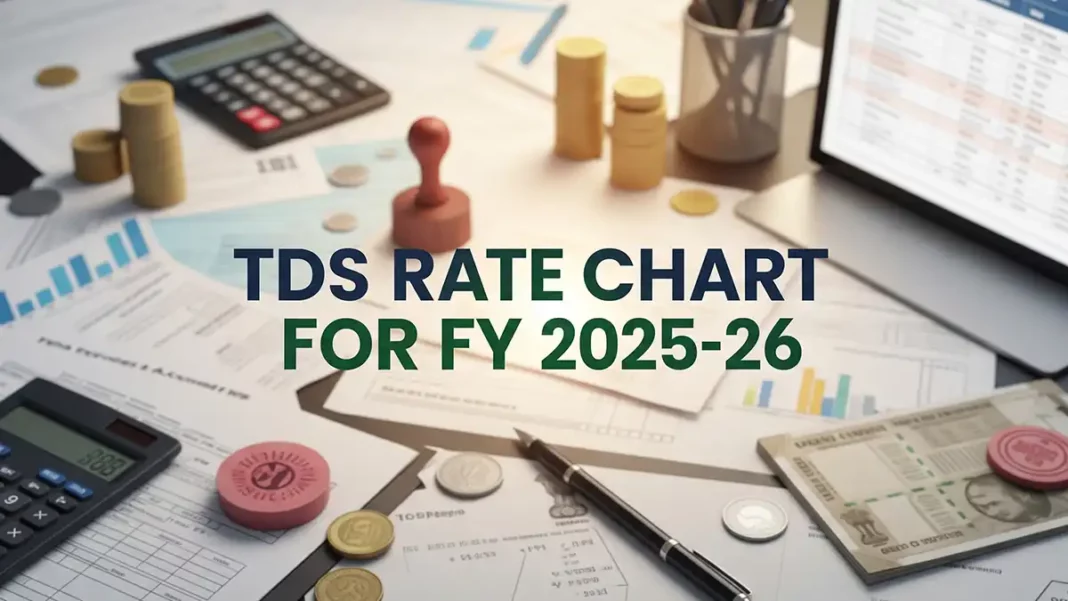The TDS rate chart for FY 2025-26 remains quite a vital reference for businesses, accounting professionals and taxpayers in India. Being able to navigate the landscape of the latest income tax TDS rates requires understanding each TDS section and keeping track of new guidelines is quite essential in order to stay compliant and avoid unnecessary penalties.
What Is the TDS Rate Chart for FY 2025-26?
The TDS rate chart for FY 2025-26 is an annual summary published by the government that clearly lists the current TDS sections and rates for various eligible payments. The chart specifically shows the most recent new TDS rates, which are effective for the fiscal year 2025-26 (assessment year 2026-27). It serves as a one-stop resource for those deducting or liable to deduct Tax Deducted at Source (TDS) under the Income Tax Act.
Why Is the TDS Rate Chart for FY 2025-26 Important?
- It specifies the list and rates of the TDS section that ensures proper deduction and remittance.
- Assists businesses in projecting liabilities and remaining compliant with all and any new statutory requirements.
- Every year, it serves as the go-to resource for updated income tax TDS rates.
Features of the TDS Rate Chart for FY 2025-26
The most recent TDS rate chart for fy 2025-26 is quite comprehensive, as it covers a wide range of transactions starting from salaries and contractor payments to dividends, rent and more. Its structure makes sure to ensure that thresholds, rates and exceptions are defined in a clear manner.
The following is a summary of some of the most relevant TDS sections and rates for fiscal year 2025-26:
| Section | Nature of Payment | Threshold | Individual/HUF (%) | Others (%) |
| 192 | Salaries | – | Slab Rate | Slab Rate |
| 192A | Premature withdrawal from EPF | ₹50,000 | 10 | – |
| 193 | Interest on Securities | ₹10,000 | 10 | 10 |
| 194 | Dividends | ₹10,000 | 10 | 10 |
| 194A | Interest (Banks) | ₹50,000 | 10 | 10 |
| 194A | Interest (Banks – older citizens) | ₹1,00,000 | 10 | 10 |
| 194B | Winnings from Lotteries | ₹10,000 | 30 | 30 |
| 194BA | Winnings from online games | – | 30 | 30 |
| 194BB | Winning in a Horse Race | ₹10,000 | 30 | 30 |
| 194C | Contractor (Single Transaction/Annual Threshold) | ₹30,000/₹1,00,000 | 1/1 | 2/2 |
| 194D | Insurance Commission | ₹20,000 | 2 | 10 |
| 194DA | Life insurance payout | ₹1,00,000 | 2 | 2 |
| 194H | Commission/Brokerage | ₹15,000 | 5 | 5 |
Prominent Entries in the TDS Chart FY 2025-26
- Section 192 (Salaries): TDS, according to the applicable income tax slab rate, is required under Section 192 (Salaries).
- Section 194A (Interest other than securities): 10% TDS is withheld when interest payments exceed the threshold, with some exceptions.
- Section 194C (Contracts): 1% for individuals/HUF and 2% for others under Section 194C (Contracts), with thresholds based on transactions or annually.
- Section 194J (Two-tier system): 10% for professional services and 2% for technical services and specific industries.
- Section 194O (E-commerce): 0.1% TDS on payments over ₹5 lakh.
TDS Section List Table: Frequently Used Codes
| TDS Section | Nature of Payment |
| 192 | Salaries |
| 192A | EPF withdrawal |
| 193 | Interest on securities |
| 194 | Dividends |
| 194A | Interest (Banks/Others) |
| 194B | Lotteries |
| 194C | Contractors |
| 194D | Insurance Commission |
| 194H | Commission/Brokerage |
| 194I | Rent |
| 194J | Professional/Technical Fees |
| 194LA | Compensation on compulsory acquisition |
| 194N | Cash withdrawals exceeding limits |
| 194O | E-commerce operator payments |
| 194R | Benefits/perquisites in business |
| 194S | Virtual digital assets |
Penalty for Non-compliance with TDS Rate Chart for FY 2025-26
Interest, late fees and penalties may cause for result from failure to comply with the FY 2025-2026 TDS rate chart. Section 201(1A) imposes a monthly interest rate of 1% in any case the TDS is not deducted or even if it is deducted at a lower rate. Interest rises to around 1.5% per month until payment is received if it is withheld but not deposited.
Section 234E charges a fee of ₹200 per day for any late TDS return filings, which is based on the total TDS amount. Furthermore, non-filing or incorrect filing may result in penalties under Section 271H that range from ₹10,000 to ₹1,00,000.
Again, if PAN is not provided, TDS must be deducted at a higher rate (usually 20%) under Section 206AA. These provisions make it quite critical to follow the TDS section list and deduct tax at the appropriate TDS rates. Complying with the TDS rate chart helps to avoid unnecessary financial liabilities.
TDS Without PAN
According to section 206AA, if, in any way, the deductee does not furnish their PAN, TDS will be deducted at the highest of:
- Prescribed rate in the Act
- Rate of force
- 20% (excluding 5% for 194O or 194Q)
Conclusion
In order to guarantee adherence to India’s income tax regulations, the TDS rate chart for FY 2025-2026 is crucial. It’s crucial for businesses and taxpayers to stay informed about changes to various TDS sections and rates, including those pertaining to digital transactions and modern revenue streams.
Understanding the TDS chart, thresholds and relevant TDS section list aids in making accurate deductions and avoiding penalties. Whether you’re dealing with salaries, contractor payments, rent, or digital asset transactions, using the correct income tax TDS rates is likely to ensure smooth, error-free financial operations in fiscal year 2025-26.
Individuals and organizations can manage their TDS responsibilities with confidence and efficiency by keeping this information readily available and up to date.
Frequently Asked Questions (FAQs)
Q: Where can I find the full TDS section list for FY 2025-26?
A: Official portals and leading tax solution providers publish the entire TDS section list, including applicable limits, payment nature and rates, in their charts.
Q: Are threshold limits in the TDS chart inclusive of GST?
A: Thresholds typically refer to the amount paid/credited, excluding GST. It’s critical to read section-specific notes.
Q: How often does the TDS rate chart change?
A: The TDS rate chart is updated annually with the Union Budget; however, interim notifications may change rates or add new sections.
Q: Is there a TDS chart for payments to non-residents?
A: Non-resident payments do have a separate TDS chart with different rates – often 20% or higher for certain incomes (royalties, fees, etc.).
Q: What is the importance of the PAN provision in the TDS chart?
A: Absence of a valid PAN results in higher TDS rates as per Section 206AA – generally 20%
Also Read:
JAA Lifestyle Login: Earn Money Online with Ease
David William comes from an Engineering background, with a specialization in Information Technology. He has a keen interest and expertise in Web Development, Data Analytics, and Research. He trusts in the process of growth through knowledge and hard work.


